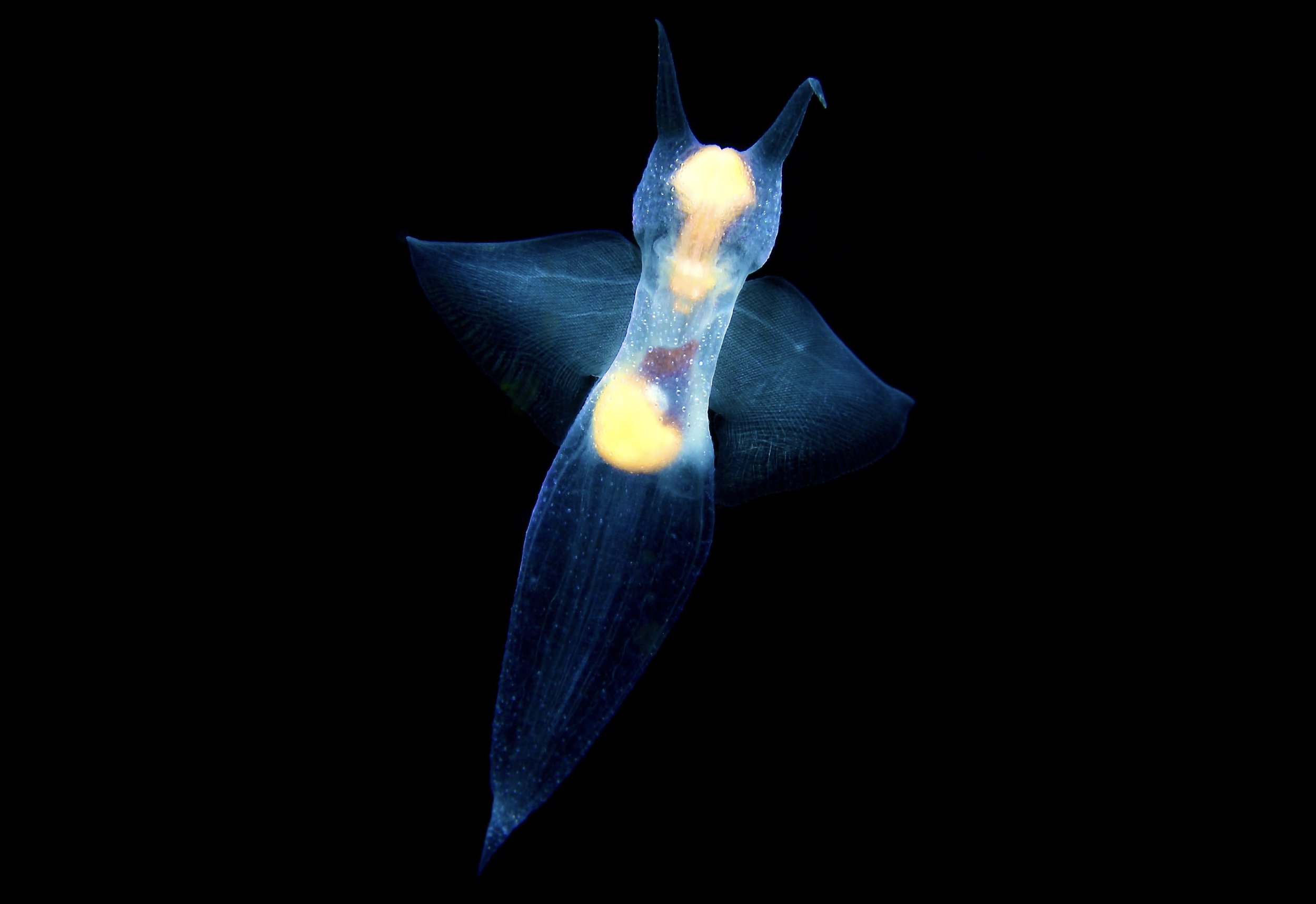Sea Angel
Clione limacina
Fluttering by in the currents, the Sea angel is among the Northeast Pacific’s strangest creatures. Without prior knowledge of its biology, it would be extremely difficult to discern exactly what type of sea creature this is. Despite being a member of the same group as sea slugs and nudibranchs, the Sea angel lives its entire life drifting through the sea, preferentially never touching the sea floor. In fact, it is possible that some individuals may go their entire lives without ever having made contact with a solid surface.
April 2020: A lone Sea angel is captured with its petal-like wings stretched open. I photographed this individual off of Tyee Spit in Campbell River, B.C.
📖 Description 📖
Sea angels are a very mysterious group of animals. While they may have a worldwide distribution they are seldom encountered, often only by scuba divers and researchers. Adding to the difficulty of the search, Sea angels are quite small, with species local to the Northeast Pacific only reaching 5cm in total length [1]. Like many other sea slugs, Sea angels have a jelly-like texture and their bodies are almost completely transparent. Their transparent skin allows us to see some of their internal organs; many of which can be a bright pink, orange, or yellow.
September 2018: A Sea angel flutters along through a kelp forest in Quathiaski Cove, Quadra Island, B.C.
🌎 Distribution 🌎
This species has what is known as a circumpolar distribution, meaning that is encountered all throughout the arctic circle. In addition, this species can be encountered as far south as Central California and Southern Japan [2]. As they are a planktonic species, they can be found great distances off shore, but may occur in very large numbers closer to the coast where plankton blooms provide them with a more ample supply of food.
Distribution of the Sea angel, Clione limacina. Suitable habitat depicted in red.
🏝 Habitat 🏝
Like many species of plankton, Sea angels live what some may call a transient lifestyle. Living in the water column, they are at the mercy of the tides and currents, which may carry them great distances over the course of their lifelong journey. In some regions, Sea angels will perform what is known as diel vertical migration. This is a phenomenon where a species will migrate to deeper waters during the daytime, and rise up during the night to feed on plankton under cover of darkness. This species can be found anywhere from the very surface of the sea down to 500m deep.
Depth of suitable habitat for the Sea angel, Clione limacina. Suitable habitat depicted in red. Not to scale.
🐚 Diet 🐚
Sea angels have a very specific diet, which consists entirely of animals known as Sea butterflies. Sea butterflies are closely related to and have a great deal in common with Sea angels, however they can be distinguished by the presence of a shell (which Sea angels do not have). When a Sea angel encounters prey, their heads appear to turn inside out, revealing a frightening maw of tentacles which are used to capture their food [3]. I have yet to witness and photograph a Sea angel capture prey, however I very much look forward to the day I get to see it myself!
April 2020: A Sea butterfly flutters along, showing its beautiful shell in full view. Photographed at the Willow Point Reef in Campbell River, B.C.
🐌 Life Cycle 🐌
The lifecycle of the Sea angel is quite similar to the sea slugs they are related to, in that they are simultaneous hermaphrodites. This means that they carry both male and female reproductive capabilities. Sea angels reproduce through internal fertilization. After an undetermined length of time, fertilized eggs are ejected inside of a gelatinous mass which drifts along until the eggs hatch. Sea angels are actually born with a shell which is discarded within a few days of birth [1].
📚 References 📚
[1] Böer, M., et al. (2005). The Arctic pteropod Clione limacina: seasonal lipid dynamics and life-strategy. Marine Biology 147:707-717. https://link.springer.com/article/10.1007/s00227-005-1607-8
[2] World Register of Marine Species. n.d. Clione limacina (Phipps, 1774) Retrieved March 20, 2023, from https://www.marinespecies.org/aphia.php?p=taxdetails&id=139178
[3] Sustainable Management of Mesopelagic Resources. (n.d.). Creature Spotlight: Sea Angel. https://summerh2020.eu/creature-spotlight-sea-angel/





